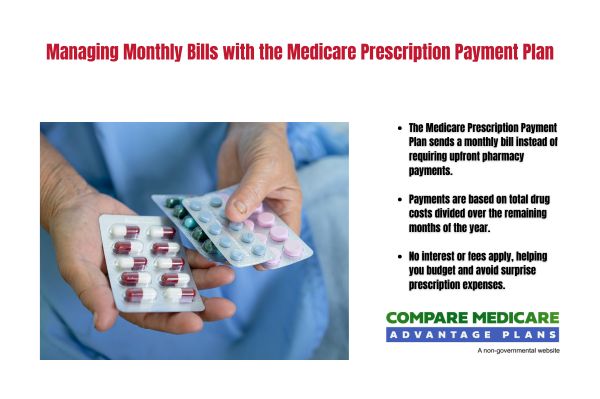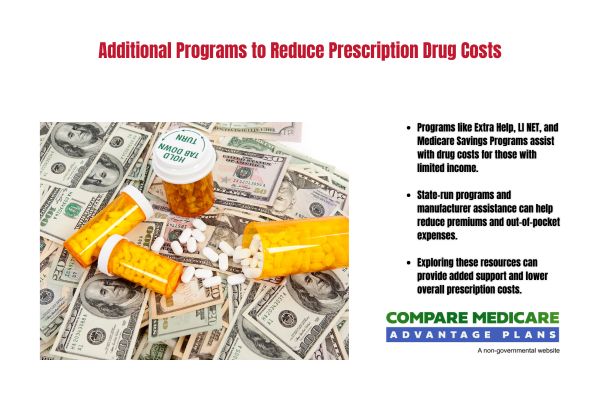




Medicare Prescription Payment Plan
The Medicare Prescription Payment Plan will likely offer a new way to handle your prescription drug costs. With this plan, you could spread out expenses into fixed, manageable monthly payments, possibly providing financial predictability and might reduce the burden of large upfront costs. This article will explore what the plan is, how to enroll, who qualifies, and how it could help manage healthcare budgets.
Key Takeaways
- The Medicare Prescription Payment Plan will likely offer optional, fixed monthly payments for prescription costs, possibly improving financial predictability for beneficiaries.
- Enrollment is straightforward, allowing participants to join at any time, with options for emergencies, likely enhancing accessibility for those in need.
- The plan will likely aim to reduce out-of-pocket costs, with an approximate $2,000 cap on annual expenses under the Inflation Reduction Act.
Compare Plans in One Step!
Enter Zip Code
What is the Medicare Prescription Payment Plan?

The Medicare Prescription Payment Plan acts as a new medicare drug plan, offering a voluntary payment option under Medicare Part D. This initiative will likely aim to bring financial predictability to those dealing with the unpredictable out-of-pocket costs for certain prescription medications. Beneficiaries may be able to manage their prescription costs with fixed monthly payments instead of paying the full amount upfront at the pharmacy.
Participation in the Medicare Prescription Payment Plan will likely be entirely optional and may be free of additional charges. It may be available to anyone enrolled in a Medicare drug plan or a Medicare health plan that includes drug coverage. This means that whether you are part of a traditional Medicare drug plan or a Medicare Advantage Plan with drug coverage, you could potentially opt into this payment method to help ease the burden of large, one-time pharmacy payments. Additionally, enrolling in this plan might not affect your credit score, and you may still receive assistance from other programs while enrolled.
This payment plan will likely be designed to simplify your financial management by potentially eliminating the need to pay at the pharmacy. Instead, you will likely receive a monthly bill covering your Part D costs and the yearly covered part, possibly allowing you to budget more effectively. With this new system, the stress of high medication costs could be significantly reduced, possibly giving you peace of mind and better control over your finances.
How to Enroll in the Medicare Prescription Payment Plan
Enrolling in the Medicare Prescription Payment Plan is straightforward and can be done at any time. However, it is recommended to opt-in before or at the beginning of the plan year to maximize the benefits and spread out costs over a longer period. First, ensure you are enrolled in a Medicare Part D plan. Then, to enroll, use this website or call one of our licensed agents at 1-833-641-4938 (TTY 711), Mon-Fri 8 am-9 pm EST.
Switching plans mid-year may require re-enrollment in the payment plan, as participation will likely end with a change in your Medicare plan. The process may be the same for both traditional Medicare and Medicare Advantage Part D drug plans, so be sure to switch plans carefully.
Eligibility Criteria for the Medicare Prescription Payment Plan
The Medicare Prescription Payment Plan will likely be designed to be accessible to a wide range of beneficiaries. Eligible individuals might include:
- Anyone enrolled in a Medicare Advantage Plan that includes drug coverage
- All individuals with a Medicare drug plan
- All individuals with a Medicare health plan with drug coverage
This could potentially ensure broad eligibility for the payment option.
Participation in the plan is optional and might not incur any additional costs. However, it’s important to note that if you switch to a new Medicare plan mid-year, your participation in the payment plan may end. You’ll likely need to opt-in again if you switch to a different Part D plan benefit package. This could potentially ensure that your payment plan stays aligned with your current Medicare drug plan.
Programs like Extra Help may offer additional assistance to those with limited income and resources, possibly covering certain drug costs. Even if you receive financial aid, you could potentially benefit from the predictability and convenience of the Medicare Prescription Payment Plan.
Managing Monthly Bills with the Medicare Prescription Payment Plan

Enrolling in the Medicare Prescription Payment Plan will likely simplify financial management. Instead of paying for prescriptions at the pharmacy, you could receive a monthly bill covering your Part D costs, which will likely detail the expenses of prescriptions filled during the month and prescriptions divided into manageable monthly payments.
The monthly bill may be calculated based on your prescription costs and the previous month’s balance, divided by the remaining months in the year. This could mean that as you fill more prescriptions throughout the year, your monthly payments may increase. However, the capped monthly payment was likely designed to help ease the burden of large, one-time pharmacy payments, possibly ensuring that you could budget effectively without any surprise expenses.
A clear, itemized monthly bill could help you stay on top of healthcare costs and possibly avoid financial strain from unexpected medication expenses.
Opting Out of the Medicare Prescription Payment Plan
Opting out of the Medicare Prescription Payment Plan is straightforward. Contact your plan at any time to disenroll.
After opting out, members should pay any outstanding balance to help avoid repercussions. You may either pay the remaining balance in full or continue with monthly payments until it is cleared. Failure to pay premiums may result in loss of coverage and disenrollment from the payment plan.
Once outstanding payments have been settled, you can re-enroll in the Medicare Prescription Payment Plan. This flexibility could potentially allow you to return to the plan if your financial situation changes or if you decide it is the best option for managing prescription drug costs.
Potential Impact on Medicare Part D Costs
The Medicare Prescription Payment Plan may have a significant impact on your Medicare Part D prescription drug costs. The Inflation Reduction Act might set an approximate $2,000 cap on annual out-of-pocket costs for Medicare Part D enrollees. This cap could potentially provide financial relief to around 11 million beneficiaries.
This potential reduction in out-of-pocket costs could make a significant difference, particularly for individuals with high prescription drug expenses. The coverage gap may also be adjusted annually for inflation, possibly ensuring that the savings continue to grow over time, likely impacting total drug costs.
Enrolling in the Medicare Prescription Payment Plan may also allow you to take advantage of these potential savings while enjoying the convenience of predictable monthly payments. This could help you better manage your healthcare budget and might reduce some of the financial stress associated with high prescription drug costs.
Additional Programs to Help Reduce Prescription Drug Costs

In addition to the Medicare Prescription Payment Plan, several other programs may be available help reduce prescription drug costs. The Extra Help program, for instance, will likely be designed to assist individuals with limited income in covering some of their Part D drug costs and possibly ensuring access to a covered drug. Those who receive full Medicaid coverage may automatically qualify for Extra Help.
The Limited Income Newly Eligible Transition (LI NET) Program could provide temporary drug coverage for individuals qualifying for Extra Help. The Medicare Savings Programs may also assist those with limited resources in meeting some of their Medicare expenses. Additionally, certain states might offer state run programs that could help to cover premiums and out-of-pocket costs for Medicare beneficiaries.
Manufacturer’s Pharmaceutical Assistance Programs could be another valuable resource, possibly offering financial aid to eligible consumers to help alleviate certain drug costs. Exploring these programs could provide Medicare patients with additional support and potentially lower their prescription drug costs even further. Additionally, some drug manufacturers, the Medicare savings program, and the state pharmaceutical assistance program may also be beneficial for those seeking further assistance.
Handling Missed Payments
If you miss a payment under the Medicare Prescription Payment Plan:
- There is a 60-day grace period to make up for the missed payment before facing disenrollment.
- During this period, you might receive a reminder to pay the outstanding balance.
- If you fail to make the payment within the grace period, you may be removed from the program.
However, you may be able to rejoin the Medicare Prescription Payment Plan by paying the owed amount. It’s important to ensure that your monthly premium has been paid on time to avoid losing your drug coverage.
Staying on top of your monthly payments could potentially allow you to continue benefiting from the predictability and convenience of the Medicare Prescription Payment Plan, possibly ensuring you receive the medications you need without financial disruption.
Summary
The Medicare Prescription Payment Plan will likely offer a valuable solution for managing the unpredictable costs of prescription medications. By spreading out these costs into fixed monthly payments, beneficiaries could potentially enjoy greater financial predictability and peace of mind. The plan is easy to enroll in and likely provides flexibility for those who need to opt-out or rejoin.
In addition to the payment plan, several other programs may be available to potentially help reduce prescription drug costs, possibly offering further financial relief to those in need. By taking advantage of these resources, you may better manage your healthcare expenses and possibly ensure that you receive the medications you need without the stress of high out-of-pocket costs.
Frequently Asked Questions
→ What is the Medicare Prescription Payment Plan?
The Medicare Prescription Payment Plan is a voluntary option under Medicare Part D that may enable beneficiaries to manage their prescription drug costs by dividing them into fixed monthly payments rather than paying the total upfront at the pharmacy. This could potentially provide financial relief for those managing their healthcare expenses.
→ How can I enroll in the Medicare Prescription Payment Plan?
To enroll in the Medicare Prescription Payment Plan, call one of our licensed agents at 1-833-641-4938 (TTY 711), Mon-Fri 8 am-9 pm EST. It’s best to enroll before or at the start of the plan year for optimal coverage.
→ What happens if I switch to a new Medicare plan mid-year?
Switching to a new Medicare plan mid-year will likely terminate your current participation in the Medicare Prescription Payment Plan, which may require you to re-enroll. Ensure you review the new plan’s benefits and coverage carefully before making the switch.
→ Are there any additional costs to participate in the Medicare Prescription Payment Plan?
Participation in the Medicare Prescription Payment Plan likely won’t incur additional costs, as it is optional for beneficiaries. Thus, you may choose to join without worrying about extra fees.
→ What should I do if I miss a payment under the Medicare Prescription Payment Plan?
If you miss a payment under the Medicare Prescription Payment Plan, you will likely have a 60-day grace period to rectify it. Failing to pay within this timeframe might result in your removal from the program, but you could rejoin by settling the owed amount.

ZRN Health & Financial Services, LLC, a Texas limited liability company



